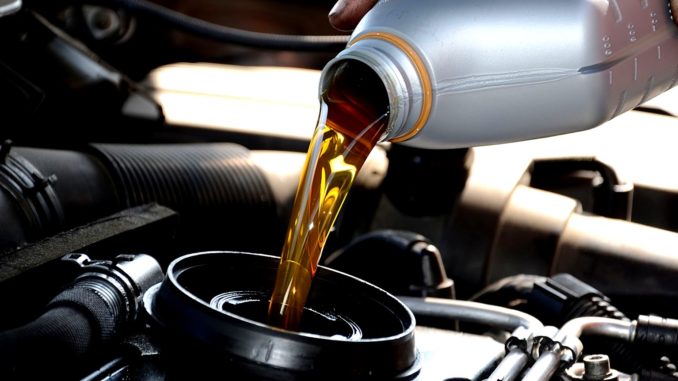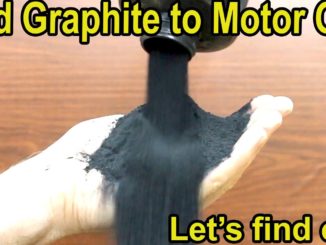
Before understanding the benefits of synthetic motor oils, you need to understand the rating system used for motor oils.
You’ll often hear 5W-30 or 0W-20 as ratings used in cars today. These are multi-grade viscosity oils, meaning their viscosity grade changes with temperature (there’s more on Oil Classifications below).
The first number, followed by a W, is the cold rating (W stands for Winter), and this means the oil behaves like an SAE 5 grade motor oil (using 5W-30 as the example) while cold, but at operating temperature, at about 100 degrees C, it operates like an SAE 30-grade motor oil.
30 is higher than 5, so initially, it may seem that the oil would get thicker at higher temperatures, which is obviously not the case.
The viscosity of an oil is its resistance to flow. A greater viscosity means more resistance to flow or thicker oil. A lower viscosity means a thinner oil.
A straight SAE 30-grade oil will be thicker at lower temperatures, as will a 5-grade oil. Even though a 30 weight oil is thicker than a 5 weight oil, at 100C the 30 weight will be thinner than cold 5-grade oil.
Low viscosity at low temperatures is important, because this is where a significant amount of engine wear occurs, so it’s critical to maximize oil flow to protect the engine.
Synthetic Lubricants Explained
By Don Stevens
All of us have seen countless ads telling us to change our engine oil every 3000 miles. Some of us have watched the infomercials showing cars driving on the racetrack with allegedly no oil or engines running on a stand while the host pours sand and gravel over an exposed valve train.
Virtually all of the lube shops have some kind of magic additive that they will say you need. What are we to believe? Or more relevant, what is right for you?
In becoming an Amsoil Synthetic Lubricants dealer in 1998 I have done a great deal of research on all kinds of lubricants and additives and in this article, I will share the facts about synthetic oils, petroleum-based oils, and additives so that you can make an informed decision about what is right for your cars.
Oil Classifications
There are two systems for oil classification. The SAE (Society of Automotive Engineers) viscosity grade and the API (American Petroleum Institute) classification that designates the type of engines for which the oil was designed. The SAE viscosity grade is known as the “W” or “winter” number when classifying oils.
Most oils on the shelf today are multi-viscosity such as 10W30 or 20W50. In general, the lower the first number, the better the oil will perform in extreme cold conditions.
Conversely, the higher the second number the better the oil will protect at higher temperatures. If you were driving to Minnesota in the winter you would want the lowest number you could find like a 0W30. In our Florida climate, however, a 10W40 or a 20W50 would be a better choice.
The API designation is typically an “S” (spark fired) designation for gasoline engines and a “C” (combustion fired) designation for diesel engines.
Most of today’s oils carry an SH,CF or SJ,CF designation signifying that they are suitable for use in all gasoline or diesel automotive applications. Those of you with diesel trucks or motor homes should look for an API CG-4 rated oil.
Which brand you buy is largely a matter of preference. Consumer Reports (6/97) found very few differences between major brands of petroleum based oil and all with the above SAE and API designations performed fine in normal applications.
>Synthetic oils were originally developed more than 50 years ago and became widely used in jet engines. Less than -120°F ambient temperatures, 60000 shaft rpm, and 500°+F exhaust temperatures proved too much for conventional oils. Synthetics were created specifically to withstand these harsh conditions and to date, every jet engine in the world uses synthetic lubricants.
Amsoil introduced the first synthetic oil for automotive use in 1972 and have continued to be at the leading edge of development ever since. Mobil-1, undoubtedly the most recognized name in synthetics, was introduced in 1976.
Many companies have jumped on the bandwagon and have since released synthetic lubricants for automotive use and all are becoming increasingly popular for their superior lubricating properties, superior ability to flow at cold temperatures, and their ability to withstand high temperatures for extended periods of time.
Several new cars including the Porsche 996 and the Chevrolet Corvette LT-1 are delivered with synthetic oil in the crankcase and require synthetic oil use throughout the life of the car.
There are two primary differences between synthetic oils and conventional petroleum oils. These are the base stock or liquid that makes up the volume of the oil, and the additive package.
There are additives (not to be confused with over the counter additives which will be discussed later) in all oils that enhance the wear resistance properties of the oil, enhance the ability of the oil to neutralize acids and combustion by-products, and provide corrosion protection for the engine’s internal surfaces.
The amount and quality of these additives vary from one oil brand to another and this is a very significant factor in the ability of an oil to adequately protect your engine in all driving conditions. As a general rule of thumb, the cheaper the oil, the fewer additives it has and therefore, the less able it is to protect your engine.
There is one school of thought that suggests that the only difference in synthetic oils vs. petroleum oils is that the synthetics typically have a better additive package. This statement is only partially true. Synthetics almost always do have superior additives than petroleum oils. While this does add to the cost of the oil, it also enables the oil to last 3-5 times longer than conventional oil.
The synthetic base stock, however, is of paramount importance in the ability of synthetic oil to flow at cold temperatures and withstand greater amounts of heat over significantly longer periods of time. Petroleum base stock molecules are long carbon chains that are sensitive to stress and heat.
Additionally, various kinds of paraffin that are contained in all petroleum products regardless of how well refined they are, cause the oil to gel like syrup at extremely cold temperatures. At the other end of the temperature spectrum, high engine temperatures and heavy loads (as typically found in towing or racetrack applications) cause these chains to break down and the base stock actually boils off causing a change of viscosity and the formulation of sludge.
This can happen at temperatures as low as 230° F and by 250° F, many petroleum oils are suffering a significant breakdown. I read a statement posted on an oil analysis web page that stated for every 20 degrees that petroleum oil is heated above 160°F, its useful life is cut in half!
Synthetic oils, on the other hand, are engineered specifically to provide all the lubricating properties that natural oil possesses, but none of the cold thickening or hot thinning properties of petroleum oil.
Synthetics are made up of uniformly shaped molecules with shorter carbon chains which are much more resistant to heat and stress. Synthetics can withstand temperatures of 300°F all day long and still protect your engine. In fact the American Society of Testing Materials (ASTM) standard wear resistance tests are conducted at 302° F.
In this test synthetic lubricants far out perform petroleum lubricants by factor of four to one and greater.
Oil temperatures of 230°F to 250°F are not at all uncommon in on track conditions. These temperatures are also fairly common in air-cooled engines in summertime stop and go traffic with the A/C on. Further, temperatures on the cylinder walls and in turbos are often over 450°F for short periods of time.
Liquid-cooled cars can also have extremely high oil temperatures even though the water temperature may be normal. I observed this first-hand several years ago in a race car where the water temperature stayed right on 210°F while the oil temperature fluctuated between 240° F and as high as 280° F depending on how hard the car was driven. Needless to say, this particular car was running synthetic oil and remarkably ran about 50 hrs. between rebuilds with no significant wear.
Further, Winston Cup star Rusty Wallace was recently quoted after the 2000 twin 125 races in Daytona that his car was running a little hot with the water temperature at 230° and oil temperature at 260°F. Rusty’s team is sponsored by Mobil 1 and I would think it is safe to say that they use the product.
Even more recently, Rusty’s teammate won the spring race in Fontana, Ca with oil temperatures reportedly pegged at 340°. There is no way conventional oils would withstand that kind of punishment.
The point of the above paragraphs is quite simply that synthetic oils have a much wider operating temperature range, by design, than petroleum oils.
Off The Shelf Additives
There are countless over the counter oil additives on the market, as there have been for a number of years. In recent years a number of companies have appeared on the scene with huge national television advertising campaigns, racecar sponsorship, and more, all designed to make the consumer believe that the products really work and you are doing yourself a favor by adding these to your car.
The fact is that these products are not necessary, do very little to help your engine, and in many cases may actually do more harm than good.
The major car companies do not endorse any of these products and in fact, your owner’s manual will undoubtedly advise you to avoid them. All the oil industry experts I have ever spoken to as well say stay away form over the counter additives.
Consumers Reports did a test (10/98) in an attempt to verify, or rebuke, one company’s ad which claimed that their product “bonded” to the engines moving parts forming a protective barrier against wear.
The ad claimed that their test car ran without any oil all over Southern California, in stop and go traffic, with the air on, for 4 hours and 40 minutes. The ad also claimed that the only reason the driver stopped was to get something to eat. These are pretty unbelievable claims.
In an attempt to prove or disprove the viability of the ad, Consumer Reports tested two Chevrolet Caprices, both with identical zero time rebuilt V6 engines. Both cars were broken in with normal petroleum oil per the manufacturer’s recommendations.
The oil and filter were then changed with one of the cars receiving the prescribed dose of this magic additive. Both cars were then driven for about 100 miles, allegedly long enough for this magical bonding to occur, and the oil subsequently drained.
Both were then driven again, now with empty crankcases, in normal traffic to see how long they would last. Interestingly both engines failed, almost simultaneously, after about 14 minutes of driving thus proving the claims of the additive manufacturer to be nonsense. Consumer Reports notified the FTC of the test and their results and the manufacturer was subsequently forced to stop running the ad.
There are some over the counter additives that contain Teflon or PTFE. Once again the ads claim that the Teflon bonds to the internal working parts of the engine forming a slippery surface (like your Teflon frying pan) and therefore reducing wear. Fundamental laws of Physics prove that such claims are impossible, as the temperatures in internal combustion engines (200°-450°F) are insufficient for any bonding to occur.
Further, independent oil analysis labs have observed that the suspended Teflon particles actually tend to accumulate the microscopic metals that are normal in engine oil formulating much larger, and potentially much more harmful, deposits in engines than would normally occur if straight motor oil had been used. In some cases, the oil filters became clogged, oil pressures dropped across the filter and oil analysis showed significantly more wear than oil alone.
Similar to the previous situation, the FTC challenged the makers of products with PTFE on their claims of “coating of PTFE” and “reduced engine wear” based again on Consumer Reports findings of “no discernible benefits” from use of the product.
The makers of these products agreed with the FTC in a settlement to stop using the above phrases in their ads. Both products, by the way, are still on the shelves luring unsuspecting victims on a daily basis.
Economics of Synthetics vs. Petroleum Lubricants
All of the manufacturers of synthetic oil tout the benefits of reduced wear, more horsepower, lower operating temperatures, and improved fuel mileage. All of these benefits are derivatives of the high-quality base stocks, better cold flow characteristics and higher levels of friction-reducing additives that are found in synthetic oils.
I can confirm better cold driving characteristics, increased fuel mileage of nearly 10%, noticeably lower operating temperatures, better heat dissipation capability, and long term high-temperature stability based on my own experience with synthetic lubricants.
Are these benefits enough, however, to persuade average drivers to give up their trusted petroleum oils and pay the extra price for synthetics?
Enthusiasts, yes. Average drivers, perhaps not. However, synthetic lubricants can endure extended drain intervals, which is a major consideration toward justification of the higher costs. For the record, most of Amsoil’s products are formulated for 25,000-mile drain intervals (with filter changes at 12,500).
This benefit is not widely promoted by the major oil producers most likely because they want you to pay a premium for their synthetic oils every 3000 miles just like their regular oils. Most companies don’t bother to tell you that synthetic oils are capable of going significantly farther than conventional oils without significant breakdown.
One Amsoil customer told me he drove his Toyota more than 50000 miles (with filter changes every 10000 miles) before oil analysis results told him it was time for a change. It is not uncommon for over the road truckers to go several hundred thousand miles between synthetic oil changes but it should also be noted that most are equipped with finer oil filtration devices than most passenger cars.
The short trips and stop and go city driving that most of do is much tougher on motor oil than over the road highway driving. In fact, frequent short trips (2 miles or less) and stop and go city driving is considered by some raters as extreme and our cars need increased protection. Fortunately, we can achieve superior protection and the economic benefits of synthetic oils while staying within the recommendations of our car manufacturers.
Consider the following economic argument. If you change your oil every 3000 miles at a quick lube center at an average price of $23.00 per change, you spend $115.00 over 15000 miles. Most synthetic oil changes cost about $50.00 (much less if you do it yourself) on which you can drive 7500 miles very safely (a 7,500-mile interval is within virtually all manufacturers’ recommendations).
Over the same 15000 miles, only two oil changes are required for an investment of $100.00. A shop could charge up to $57.50 and it is still a break-even proposition, plus you put a superior product in your car and are receiving the additional benefits that synthetic lubricants can provide.
I typically drive about 12000 miles between changes with a filter change and oil analysis at 6000. I just passed 15000 miles on one of my cars and even after 15000 miles oil analysis advises that the oil is “suitable for continued use”.
Also, typically the wear metals are less than conventional oil after 3000 miles. In fact, in a test performed by Popular Mechanics some years ago, oil analysis showed in New York City taxicabs that there is typically less oil breakdown and less wear metals in Amsoil 10W40 synthetic oil after 60000 miles (albeit with bypass filter changes every 6000 miles) vs. conventional 10W40 oil after 3000 miles. As an added benefit, less waste oil is being put back into the environment. A true win-win proposition.
Conclusion
Most major brand name petroleum oils perform adequately provided your driving conditions are normal and provided you change the oil regularly (remember, short city trips, track events, dusty conditions, and towing are considered extreme).
Over the counter additives have been proven to be of little to no benefit, often do more harm than good, and are a waste of money regardless of what you drive and how you drive it.
Finally, for those of you who drive your vehicle hard, tow a trailer, drive very short distances, sit idling and in stop & go traffic for long periods, live in a cold climate and/or if your car runs hot, quality synthetic motor oil, synthetic gear lube, and synthetic automatic transmission fluid is a wise investment that will provide the additional protection you require as well as last thousands of miles longer than conventional lubricants.
Don Stevens is a mechanical engineering graduate of the Ohio State University and has been a member of the Suncoast Region of the PCA and BMWCCA for 14 years. He is also a 10-year veteran road racer/driving instructor with hundreds of hours of seat time and several endurance race wins to his credit.




